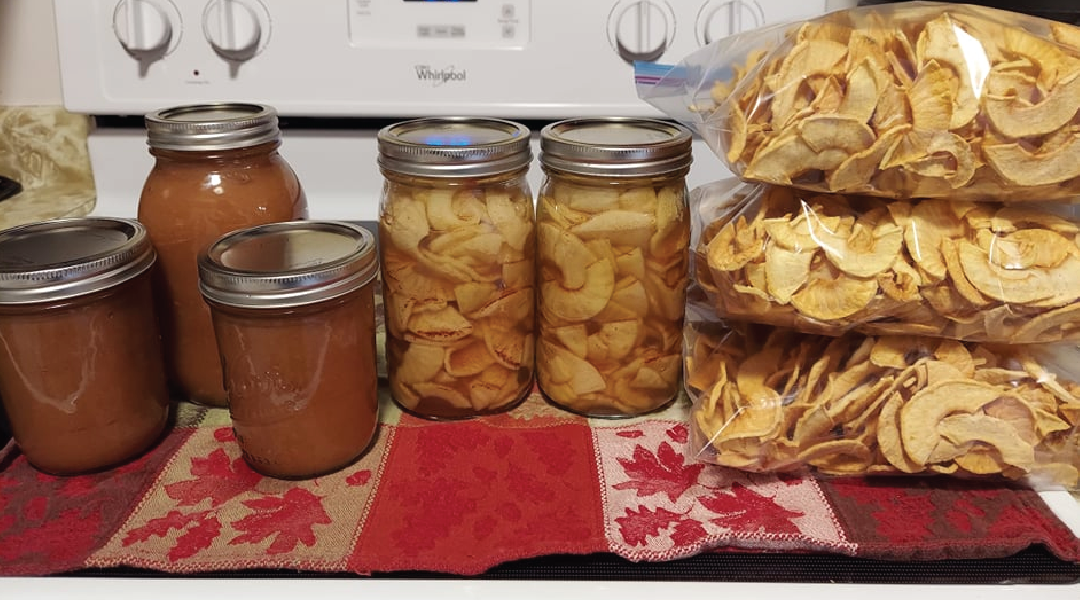Preserving the Harvest
Food preservation is both a science and a timeless tradition—an empowering way to extend the harvest, reduce waste, and enjoy the flavors of each season year-round.
Food preservation is the process of treating and handling food to slow down spoilage, prevent foodborne illness, and maintain nutritional value, texture, and flavor (Source: Food Spoilage Microorganisms, 2006). For centuries, humans have developed creative methods to make seasonal abundance last through the year — combining science, craft, and care.
Types of Food Preservation
Freezing
Foods can be blanched, cooked, or packed (dry or wet) before freezing, keeping them fresh for up to 18 months.
Dehydrating
Using gentle heat (below 200°F) or air circulation, moisture is removed from foods to make them shelf-stable for up to a year.
Canning & Bottling
Foods are sealed in glass jars and heated in a water bath or pressure canner, creating a shelf-stable product that can last up to two years.
Pickling
A vinegar-and-salt brine preserves produce and enhances flavor. Pickled foods can be refrigerated or canned for longer shelf life.
Jams & Jellies
Fruit, sugar, spices, and pectin are cooked together to create spreads that can be canned or stored in the fridge or freezer.
Fermenting
Natural or added yeasts and bacteria transform sugars into acids, gases, or alcohols, extending shelf life and adding beneficial microbes. Lifespan depends on the food type and storage conditions.
Smoking
Hot or cold smoking adds flavor and preserves meats, cheeses, and produce. Smoked meats may last for months, while cheeses and vegetables typically require refrigeration or freezing.
Infusions
Soaking herbs, fruits, or spices in oil or vinegar captures their flavors. Infusions can last 3–12 months depending on ingredients and storage. Infused salts, when dehydrated, can last for years.
Cold Storage & Root Cellaring
Some produce, like apples, winter squash, and onions, can be stored for months when kept at optimal temperature and humidity.
Dehydrating veggies for soup mixes
Getting Started: Preparation
Successful preservation begins with good planning and food safety. Gather all necessary equipment, ingredients, and storage space before starting. For detailed guidance, contact your local university extension service or consult an up-to-date book on food preservation.
Food Safety First
Nothing matters more than safety. History is full of cautionary tales about improperly stored foods. Thanks to modern knowledge and sanitation practices, we can confidently preserve food while protecting our health.
Always research trusted methods, keep your workspace clean, and make sure your containers are properly sanitized.
Equipment
Each preservation method requires specific tools — some may already be in your kitchen, while others can be borrowed or purchased. Check your equipment list before you begin.
Ingredients
The quality of your preserved foods depends on the freshness and integrity of your ingredients. Choose local, seasonal produce, herbs, and spices whenever possible. For meats, freshness is key.
Timing
Preservation takes time — often more than expected. Plan ahead for cleaning, preparation, cooking, storing, and cleanup. Schedule your preserving days thoughtfully, especially when your ingredients are freshly harvested.
Storage
Consider where and how you’ll store your preserved foods:
Do you have enough freezer or pantry space?
Is your cold storage room at the right humidity?
Are your containers airtight and properly labeled?
Success depends on creating the best possible conditions to keep your food safe, delicious, and nourishing for months to come.
Apples 3 ways - dried, pie filling & sauce
Resources
The Art of Fermentation, Katz, 2012
The Big Book of Preserving the Harvest, Costenbader, 2002
The All New Ball Book Of Canning, by Ball Home Canning Test Kitchen, 2016
“Preserving and Preparing Food Safely.” University of Minnesota Extension. https://extension.umn.edu/food-safety/preserving-and-preparing. Accessed 15 Aug. 2024.
Root Cellaring: Natural Cold Storage of Fruits & Vegetables, Bubel, 1991




